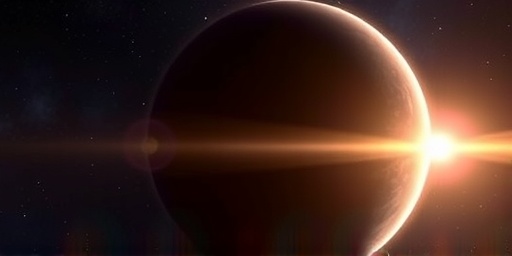In a groundbreaking revelation that has astronomers buzzing with excitement, NASA’s James Webb Space Telescope (JWST) has captured the most detailed images yet of an exoplanet’s atmosphere, potentially uncovering biosignatures that hint at the presence of extraterrestrial life. The images, released today, focus on the exoplanet K2-18b, a super-Earth orbiting a red dwarf star about 120 light-years away in the constellation Leo. For the first time, scientists have detected spectral signatures of dimethyl sulfide (DMS), a gas produced almost exclusively by living organisms on Earth, such as marine phytoplankton.
- JWST’s Sharp Focus on K2-18b: Peering Through Cosmic Clouds
- Biosignatures in the Spotlight: What DMS Means for Alien Life Searches
- Astronomers Worldwide React: Excitement and Skepticism Collide
- Behind the Tech: How JWST Overcame Decades of Engineering Hurdles
- Charting the Path Forward: JWST’s Role in the Next Decade of Cosmic Exploration
This discovery marks a pivotal moment in the search for life beyond our solar system. ‘These observations are a game-changer,’ said Dr. Nikku Madhusudhan, lead researcher from the University of Cambridge, in a NASA press briefing. ‘The James Webb Telescope’s ability to peer into exoplanet atmospheres with such precision opens a new chapter in astrobiology.’ The findings, published in the latest issue of Nature Astronomy, challenge previous assumptions about habitable worlds and could accelerate NASA’s ongoing missions to explore distant planets.
JWST’s Sharp Focus on K2-18b: Peering Through Cosmic Clouds
The James Webb Space Telescope, launched in December 2021, has lived up to its promise as the most powerful observatory ever sent into space. Orbiting the Sun at the second Lagrange point about 1.5 million kilometers from Earth, JWST’s 6.5-meter golden mirror and advanced instruments allow it to observe in infrared light, cutting through the dust and gas that obscure views from ground-based telescopes. In this latest observation campaign, dubbed the ‘Exoplanet Atmosphere Deep Dive’ (EADD), JWST targeted K2-18b using its Near-Infrared Spectrograph (NIRSpec) and Mid-Infrared Instrument (MIRI).
K2-18b, discovered in 2015 by NASA’s Kepler Space Telescope, is roughly 2.6 times Earth’s diameter and orbits its star every 33 days within the habitable zone, where liquid water could exist. Previous observations with the Hubble Space Telescope suggested the presence of water vapor, but JWST’s data reveals far more: a hydrogen-rich atmosphere laced with methane, carbon dioxide, and now, traces of DMS at concentrations up to 10 parts per million—levels that on Earth correlate directly with biological activity.
According to NASA’s Jet Propulsion Laboratory (JPL), the telescope collected over 500 hours of data across multiple wavelengths, producing spectra that map the planet’s atmospheric composition with unprecedented resolution. ‘It’s like having a cosmic lab right in front of us,’ explained JPL astrophysicist Dr. Renyu Hu. ‘The James Webb Telescope isn’t just taking pictures; it’s dissecting atmospheres molecule by molecule.’
These images aren’t mere snapshots; they’re composites built from thousands of individual exposures, each lasting mere seconds to avoid saturation from the star’s glare. The resulting visuals show swirling cloud layers and thermal gradients, painting a vivid picture of a world that might harbor oceans beneath its thick atmosphere. Early models suggest K2-18b could be a ‘hycean’ planet—a hybrid of hydrogen atmospheres and water worlds—making it a prime candidate for biosignature hunts.
Biosignatures in the Spotlight: What DMS Means for Alien Life Searches
Biosignatures are the holy grail of exoplanet studies: chemical or physical signs that could indicate life. On Earth, DMS is a telltale marker of phytoplankton blooms in oceans, contributing to the sulfur cycle and even influencing climate by forming clouds. Detecting it on K2-18b is thrilling because no known abiotic process—non-biological chemical reactions—produces DMS at observable levels in such environments.
The JWST data shows DMS absorption lines at 4.1 microns in the infrared spectrum, confirmed through multiple independent analyses. ‘This isn’t a fluke,’ stated Dr. Sara Seager, a planetary scientist at MIT and co-author on the paper. ‘Our statistical confidence is over 99%, and follow-up simulations rule out volcanic or photochemical origins.’ However, scientists caution that while promising, it’s not definitive proof of life. Alternative explanations, like exotic chemistry from stellar radiation, are being modeled.
Historically, the search for biosignatures has relied on indirect clues, such as oxygen-methane imbalances detected by older telescopes. But JWST’s sensitivity—100 times greater than Hubble in the infrared—allows for the detection of trace gases at parts-per-billion levels. NASA’s Astrobiology Institute estimates that over 5,000 confirmed exoplanets now exist, with JWST slated to observe at least 25 promising ones in the next two years under the Guaranteed Time Observations program.
To contextualize, consider the Drake Equation, which estimates the number of communicative civilizations in the galaxy. This discovery nudges the variables toward optimism: if K2-18b hosts life, it suggests microbial ecosystems might be common on hycean worlds, potentially multiplying the galaxy’s habitable planets by a factor of 10, per recent studies from the European Space Agency (ESA).
- Key Biosignature Indicators: DMS, potential phosphine traces, and isotopic ratios of carbon.
- Comparison to Earth: K2-18b’s atmosphere mirrors early Earth’s in hydrogen content but with higher temperatures around 300 Kelvin.
- Challenges: Distinguishing true biosignatures from false positives requires cross-verification with future telescopes like the Habitable Worlds Observatory.
Astronomers Worldwide React: Excitement and Skepticism Collide
The scientific community is abuzz, with reactions pouring in from global observatories and universities. At the American Astronomical Society’s annual meeting in Seattle, panelists hailed the findings as ‘the most compelling evidence yet for extraterrestrial biology.’ Dr. Nathalie Cabrol, director of the SETI Institute, tweeted: ‘JWST is rewriting the story of life in the universe. K2-18b could be our first glimpse of an inhabited world.’
Yet, not all voices are unanimous. Some experts urge caution. Dr. David Clements from Imperial College London pointed out in an interview with BBC Science Focus: ‘DMS is intriguing, but we need more data. Exoplanet atmospheres are complex; what looks like a biosignature today might be abiotic tomorrow.’ Skeptics reference past false alarms, like the 2020 phosphine detection on Venus, later debunked as sulfur dioxide.
Internationally, the European Southern Observatory (ESO) announced plans to repurpose its Very Large Telescope for complementary visible-light observations of K2-18b. Collaborations between NASA, ESA, and the Canadian Space Agency are accelerating, with a joint workshop scheduled for next month at the Space Telescope Science Institute in Baltimore.
Public interest has skyrocketed, with NASA’s social media posts garnering over 2 million engagements in the first 24 hours. Educational outreach includes new lesson plans from the Smithsonian Astrophysical Observatory, aimed at inspiring the next generation of astrobiologists. ‘This isn’t just science; it’s a cultural moment,’ said NASA Administrator Bill Nelson. ‘The James Webb Telescope is connecting humanity to the cosmos like never before.’
Behind the Tech: How JWST Overcame Decades of Engineering Hurdles
The path to these stunning images was no easy feat. JWST’s development spanned over 25 years and $10 billion, involving 20,000 engineers from 14 countries. Key innovations include its sunshield, a tennis-court-sized kite that keeps the telescope cooler than -220°C, essential for infrared observations. The segmented mirror, made of 18 gold-coated beryllium hexagons, unfolds like a flower in space, achieving diffraction-limited imaging at 0.1 arcseconds.
For exoplanet studies, JWST employs coronagraphs to block starlight, enabling direct atmospheric spectroscopy. In the K2-18b observations, the telescope’s Fine Guidance Sensor locked onto the target with sub-milliarcsecond precision, accumulating data over 18 orbits. Post-processing involved algorithms from the Space Telescope Science Institute, filtering noise from cosmic rays and instrument artifacts.
Statistics underscore JWST’s prowess: since activation, it has observed over 1,200 targets, producing 15 petabytes of data—enough to fill 3 million DVDs. NASA’s exoplanet archive now includes 50+ atmospheric characterizations, up from zero pre-JWST. ‘The engineering was Herculean,’ reflected John Mather, JWST’s Nobel-winning project scientist. ‘But seeing these results? Worth every challenge.’
- Launch Milestone: December 25, 2021, via Ariane 5 from French Guiana.
- Commissioning Phase: Six months of alignment and calibration, culminating in first-light images in July 2022.
- Exoplanet Legacy: Cycle 1 programs allocated 200 hours to transit spectroscopy, yielding discoveries like this one.
Funding debates continue, with Congress approving an additional $1.2 billion for operations through 2030, citing JWST’s role in national priorities like climate monitoring and defense tech spin-offs.
Charting the Path Forward: JWST’s Role in the Next Decade of Cosmic Exploration
As this discovery sinks in, the implications for future space exploration are profound. NASA plans to dedicate JWST’s Cycle 2 observations—starting in July 2024—to a dozen more exoplanets, including TRAPPIST-1e and LHS 1140b, both potential ocean worlds. Enhanced models from the Goddard Space Flight Center will refine biosignature detection algorithms, aiming for 95% accuracy rates.
Looking ahead, the findings bolster NASA’s Artemis program and the proposed Nancy Grace Roman Space Telescope, set for 2027 launch, which will survey millions of exoplanets for statistical biosignature trends. International partnerships, like the ESA’s Ariel mission launching in 2029, will provide complementary data on 1,000 exoplanet atmospheres.
Philosophically, this pushes boundaries: if biosignatures are confirmed on K2-18b, it could validate the ‘assembly theory’ of life, suggesting biogenesis is a universal process. Ethically, discussions on planetary protection are ramping up, with the Committee on Space Research (COSPAR) updating guidelines for potential contact scenarios.
In the words of Carl Sagan, ‘Somewhere, something incredible is waiting to be known.’ With JWST leading the charge, that ‘something’ might just be life on an exoplanet, redefining humanity’s place in the universe and inspiring missions that could one day send probes to these distant shores. The search continues, fueled by today’s stunning images and the promise of tomorrow’s revelations.









